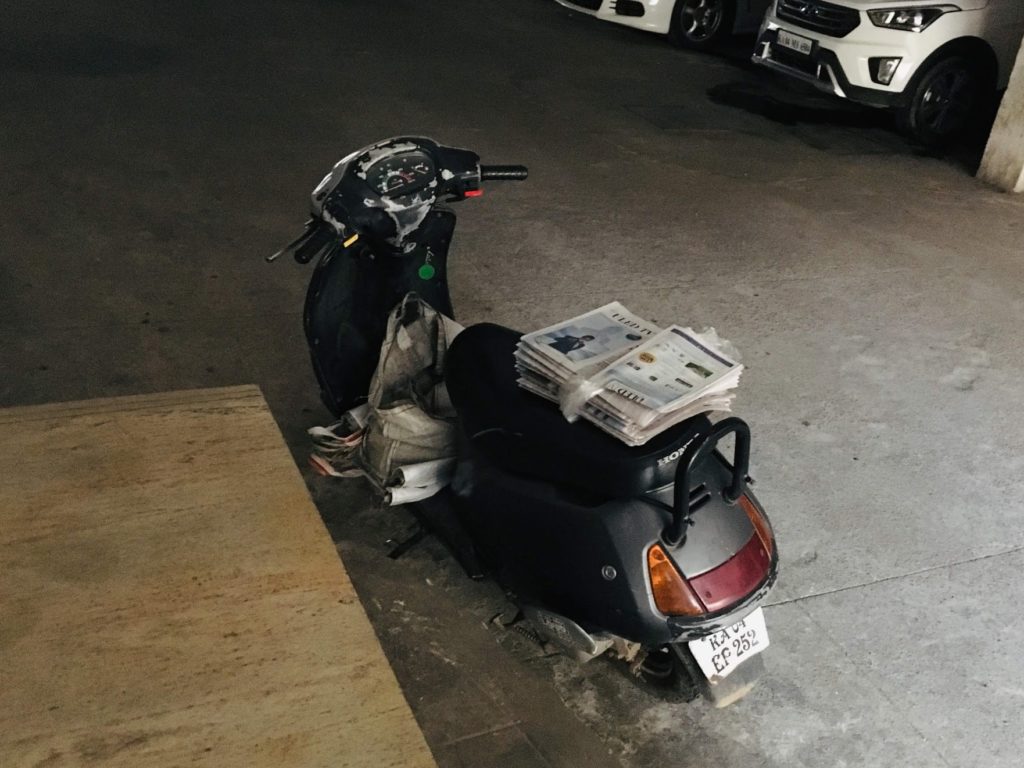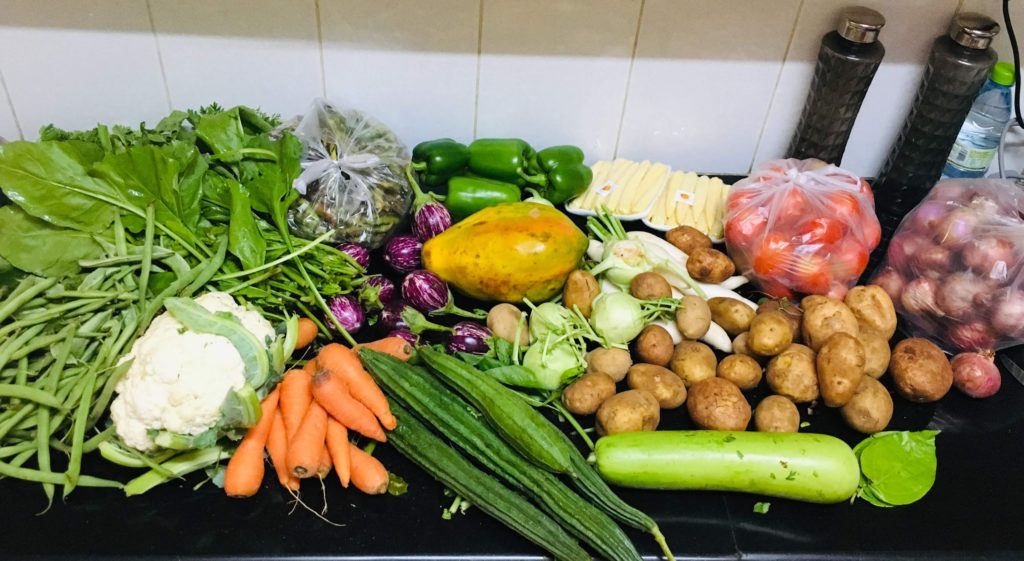The cost of living in India is about 65 percent less than that in the United States, and currently one US dollar exchanges to about 69 Indian rupees. I asked you all on Facebook what you were curious to know the price of and these are some of the things you said. A couple of them (like, lentils) I’m still hunting down the price for. I’ve also converted all of the currencies for you, so … you’re welcome.
Gasoline: $3.44/gallon
It’s sold by the liter here and the price is fixed by the government. Every morning at 6, the petrol and diesel prices are released.
Electricity: $24.60/month
Cow’s milk: $2.34/gallon
We buy it in half-liter or one liter quantities and we pre-purchase coupons which we leave outside our door each evening. Every morning around 7, there’s a milk delivery guy who delivers the milk in plastic bags. (He’s also the guy who delivers the newspapers.)
Fruits and veggies: The price varies based on the product and the price-per-kilogram. The loot below cost about $8.70
Netflix: $7.25/month
We got three months free when we got our cellphone plans.
Yummy coffee: $2.58 for a small cup of regular coffee from Cafe Coffee Day (the Starbucks of India).
Dog food: $95 for 26 pounds
There are cheaper options but not ones that meet the health requirements we have for the dogs. We found a brand that is mid-to-upper quality and price. We’re not thrilled about paying that much, but we also don’t like the alternative of a raw food diet.
Clothes: Varies!
It depends on what you’re shopping for and where. The malls obviously have prices that westerners are more familiar with. Local markets and some of the commercial districts have better prices. A couple examples: We spent about $100 at a jeans store and that bought me a pair of shorts and a pair of work pants, and Murali got two pairs of shorts and two pairs of pants. At another store, I bought a sundress for $7. Murali bought pajama pants for about $5.
Shoes: Again, it just depends on where you’re shopping and what you’re shopping for. You can buy sandals in local markets for about $2, and you can buy Adidas tennis shoes for $160.
American brands are going to be hella expensive because of the import taxes and fees, but you can get the same quality/different brand.
A newspaper: $4.90/month for two daily newspapers
Diapers: $20 for a package of 152 diapers
Sidenote: We were traveling last week and ran out of packed diapers, so we went to a local medical shop to pick some up. They sold them in a package of five for 87 cents. Many items are sold in small quantities like this to make purchasing easier for the working class.
Bottled water: 43 cents for a small bottle of water
Rent: Obviously this depends on where you live in the city and what type of house you live in. It’s possible to rent a two-bedroom apartment for about $202 a month. If you live in the part of town that we live in, rent can be upwards of $1,000 for a 3-bedroom apartment.
Side note on apartments: Each unit is owned by a different owner, which means that the prices fluctuate per unit, and the prices are negotiable.
Healthcare: This varies, but some personal examples (with no insurance):
- I saw a foot specialist for $11.60
- Saira’s vaccines cost about $144
- A recent root canal cost about $73
- A bottle of crocin (equivalent to children’s tylenol) cost 43 cents (compared to $6 at Target)
- A large bottle of her gripe water cost 87 cents (compared to $11 at Target)
Transportation: This varies, but I’ll give you some examples:
- Our 19-mile Uber ride to the airport is between $8 and $11
- Our recent 3-hour bus journey cost $4.70 per person
- Flights to main cities in India are between $45 and $120
- A one-mile auto ride to Saira’s pediatrician is about 58 cents
WiFi: $17.40/month unlimited
Cable TV: $8/month
Education: I haven’t been able to pinpoint the cost of tuition fees here, but I did have an interesting conversation with some of my students this week about student loan debt in the United States. They were baffled and wanted to know if what they’d read and seen documentaries about was true. Are there homeless college students? Why is college so expensive? Among their questions are a couple I think illustrates their personal experiences: “Don’t they have family wealth to pay for it?” “Why don’t their parents send them money?” ”
Restaurants: This varies too depending on where you go, but from personal experience, here are some examples:
- At our favorite local spot, three people can eat an awesome meal for about $10.80 (that’s total, not per person)
- On the other hand, a date night out at a mid/upscale restaurant can easily cross $75 when you add in drinks
- Cocktail prices are about the same as in the US (disappointing!)
Services:
Lots of things could go in this category, but I’ll give you a few examples:
- A housecleaner six days a week: $58/month
- A cook six days a week (one meal): $44/month
- Drivers for all day excursions: about $26 to $40
I’ll add a couple of things:
- Sanitary napkins: they come in packages of 7 or 8 and the package costs about 41 cents
- Cough drops: these are commonly sold per cough drop and each one costs about 7 cents
- Eyebrow/lip/chin threading: all of it costs about $1.15
- Personal training: about $145/month
- Cellphones (two lines/unlimited talk/text and 200GB of data): $10.80/month




Comments